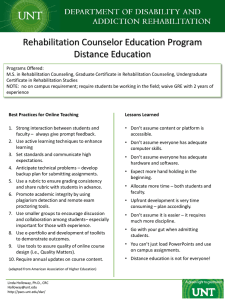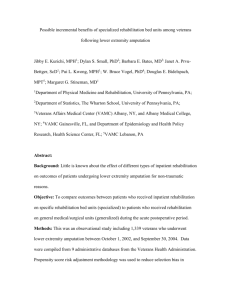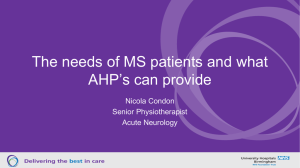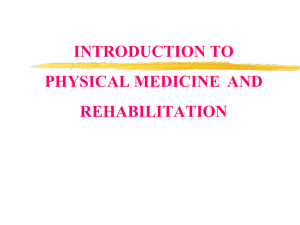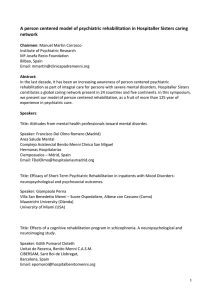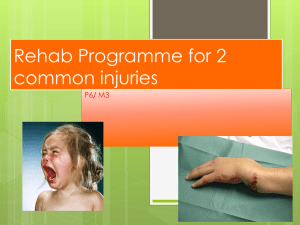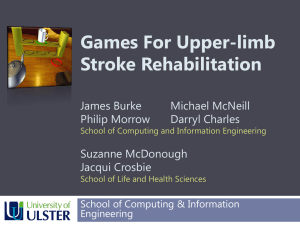Bringing Real Context with a Virtual World
advertisement
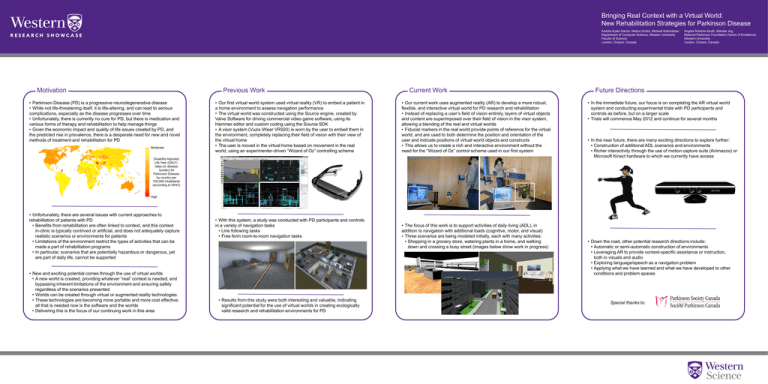
Bringing Real Context with a Virtual World: New Rehabilitation Strategies for Parkinson Disease Andrés Ayala Garcia, Nelson Andre, Michael Katchabaw Department of Computer Science, Western University Faculty of Science London, Ontario, Canada Motivation Previous Work • Parkinson Disease (PD) is a progressive neurodegenerative disease • While not life-threatening itself, it is life-altering, and can lead to serious complications, especially as the disease progresses over time • Unfortunately, there is currently no cure for PD, but there is medication and various forms of therapy and rehabilitation to help manage things • Given the economic impact and quality of life issues created by PD, and the predicted rise in prevalence, there is a desperate need for new and novel methods of treatment and rehabilitation for PD Moderate • Our first virtual world system used virtual reality (VR) to embed a patient in a home environment to assess navigation performance • The virtual world was constructed using the Source engine, created by Valve Software for driving commercial video game software, using its Hammer editor and custom coding using the Source SDK • A visor system (Vuzix iWear VR920) is worn by the user to embed them in the environment, completely replacing their field of vision with their view of the virtual home • The user is moved in the virtual home based on movement in the real world, using an experimenter-driven “Wizard of Oz” controlling scheme Current Work • Our current work uses augmented reality (AR) to develop a more robust, flexible, and interactive virtual world for PD research and rehabilitation • Instead of replacing a user’s field of vision entirely, layers of virtual objects and content are superimposed over their field of vision in the visor system, allowing a blending of the real and virtual worlds • Fiducial markers in the real world provide points of reference for the virtual world, and are used to both determine the position and orientation of the user and indicate positions of virtual world objects and constructs • This allows us to create a rich and interactive environment without the need for the “Wizard of Oz” control scheme used in our first system Disability Adjusted Life Year (DALY) rates (or disease burden) for Parkinson Disease by country per 100,000 inhabitants (according to WHO) Angela Roberts-South, Mandar Jog National Parkinson Foundation Centre of Excellence Western University London, Ontario, Canada Future Directions • In the immediate future, our focus is on completing the AR virtual world system and conducting experimental trials with PD participants and controls as before, but on a larger scale • Trials will commence May 2012 and continue for several months • In the near future, there are many exciting directions to explore further: • Construction of additional ADL scenarios and environments • Richer interactivity through the use of motion capture suits (Animazoo) or Microsoft Kinect hardware to which we currently have access High • Unfortunately, there are several issues with current approaches to rehabilitation of patients with PD • Benefits from rehabilitation are often linked to context, and this context in-clinic is typically contrived or artificial, and does not adequately capture realistic scenarios or environments for patients • Limitations of the environment restrict the types of activities that can be made a part of rehabilitation programs • In particular, scenarios that are potentially hazardous or dangerous, yet are part of daily life, cannot be supported • New and exciting potential comes through the use of virtual worlds • A new world is created, providing whatever “real” context is needed, and bypassing inherent limitations of the environment and ensuring safety regardless of the scenarios presented • Worlds can be created through virtual or augmented reality technologies • These technologies are becoming more portable and more cost effective; all that is needed now is the software and the worlds • Delivering this is the focus of our continuing work in this area • With this system, a study was conducted with PD participants and controls in a variety of navigation tasks • Line following tasks • Free form room-to-room navigation tasks • Results from this study were both interesting and valuable, indicating significant potential for the use of virtual worlds in creating ecologically valid research and rehabilitation environments for PD • The focus of this work is to support activities of daily living (ADL), in addition to navigation with additional loads (cognitive, motor, and visual) • Three scenarios are being modeled initially, each with many activities: • Shopping in a grocery store, watering plants in a home, and walking down and crossing a busy street (images below show work in progress) • Down the road, other potential research directions include: • Automatic or semi-automatic construction of environments • Leveraging AR to provide context-specific assistance or instruction, both in visuals and audio • Exploring language/speech as a navigation problem • Applying what we have learned and what we have developed to other conditions and problem spaces Special thanks to:





